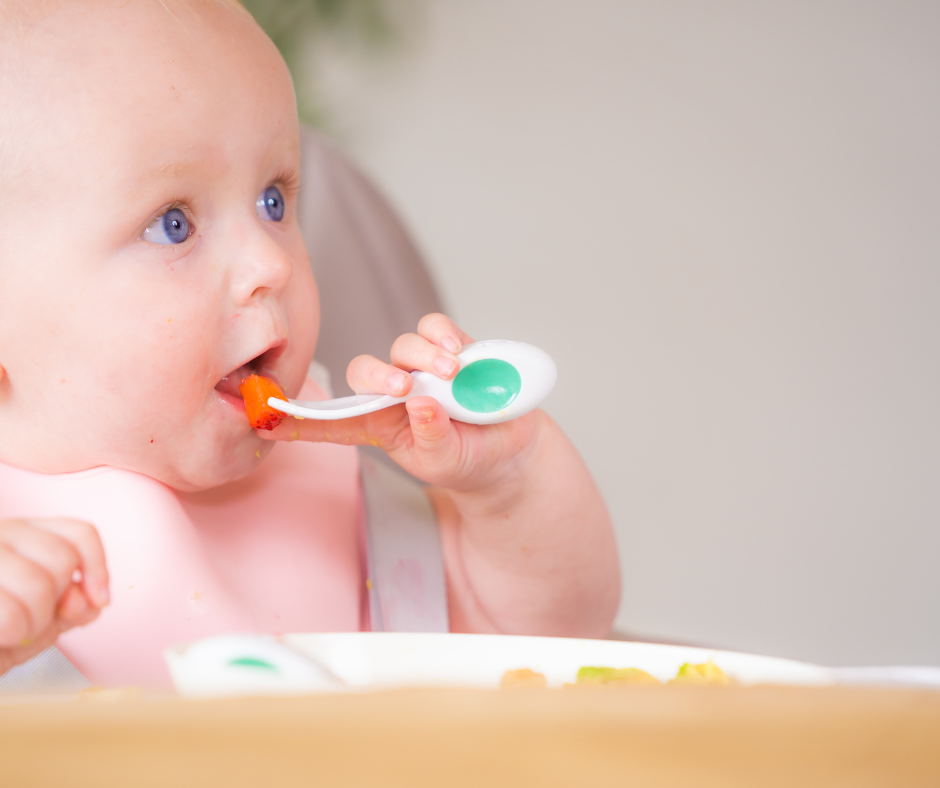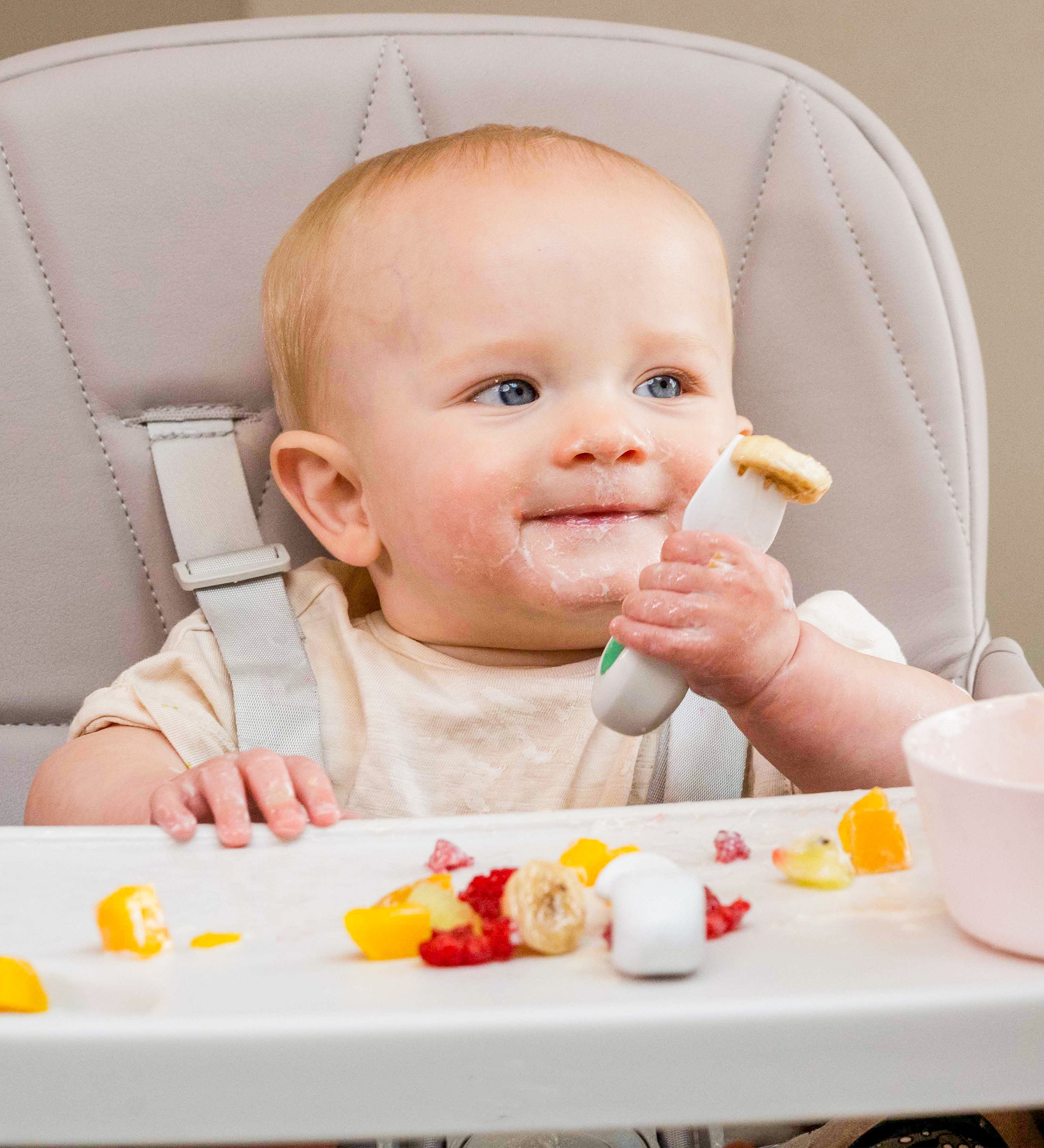The transition from milk to solids is an exciting milestone. And as your baby grows, you'll start noticing signs they are ready to explore new textures and flavours beyond milk. It can be a nerve-wracking time for any parent. But don't worry, we’ve got a step-by-step guide of everything you need to know.
So, when should you start? How do you know if they are ready? What if your baby chokes? This article will walk you through the entire process so you can confidently introduce solids to your little one. If you learn just one thing, it’s to follow your baby’s lead as their own little guide. Before you know it, you’ll have a confident baby food explorer on your hands.

Introducing Solid Foods to Your Baby
Starting solids is a key development milestone in your baby's life - unleashing independence for the first time. As your baby approaches 6 months, they'll start showing more interest in foods beyond breastmilk or formula. And while milk remains a crucial part of their diet now, exploring some solid tastes and textures opens up a whole new world of flavour and skills for your little one's developing mind and body.
The key here is to let your baby guide the timing. Watch for those early signs that they have the coordination to handle solid food, and the curiosity that speaks to their readiness. Once you spot those cues, you’ll know your child is eager to dig into the world beyond milk.
Let’s start by covering the signs to look out for so you can feel certain your baby is ready for this next big adventure.
When to Introduce Solids

We know each child develops on their own timeline, there’s no one-solids-schedule-fits-all and that’s just fine. The NHS recommends introductions around 6 months on average. Of course, every parent knows their child best. You might notice your little one showing signs earlier, or needing a little more time to build coordination.
Some signs your baby might be ready to dive into solids include:
- Staying upright.
- Holding head steady.
- Losing tongue thrust reflex (swallowing food instead of pushing it out with the tongue).
- Developing hand-eye coordination.
- Reaching for food or your plate with curiosity.
As this age approaches, the best thing you can do is keep an eye out. You’ll notice your baby demonstrating newfound strength, coordination, and curiosity for all the flavours beyond milk. Once those signs emerge, you can take the plunge together and start to introduce solid foods.
How to Start Solid Foods

So, your little one is showing all the signs they are ready to move past just milk. Now what? Time to have some fun. Here’s a handy step-by-step guide so you can take it slow and steady together.
The first step to starting your baby on solid foods is choosing your preferred weaning method:
- Spoon Feeding: Start with purees served on a spoon. Encourage responsive feeding, either by yourself or allowing the baby to hold the spoon.
- Baby-Led Weaning (BLW): Allow your baby to explore and self-feed by placing appropriate foods in front of them.
- Combination Feeding: Combine spoon-fed foods with finger foods, offering both textures.
It’s all about whatever works for you and your baby. Don’t hesitate to experiment with different methods – whether it’s spoon feeding, Baby-Led Weaning (BLW), or a combination of both. Here are some tips to help navigate this phase:
Begin by trying one new tasting per day after their usual milk feeds. We don’t want to overwhelm their senses.
- For spoon feeding, start with thin, smooth purees. Or, for BLW, offer soft, easy-to-grasp foods like steamed veggies or fruits. Then gradually introduce new textures over the coming weeks so they can master each one.
- Stick to single-ingredient foods at first. This helps identify any preferences or reactions before combining flavours.
- Just a spoon or two at first for those spoon feeding. And for BLW, explore different amounts of finger foods or self-fed portions. Let your baby set the pace so they don’t get full on milk alone.
- Encourage every taste and texture positively. Trying new things is scary (for you and for them!), but their curiosity will be sparked in no time with your support.
The key for stress-free success is letting your child guide the process as you gently introduce solids. Pay attention to their fullness signals, just like you mastered with milk feeding. And don’t worry if they push some tastes away at first. Just offer new flavours frequently with patience and positivity.
Tip! It may get messy. But it’s oh-so worth it, so the best advice we can give is to just embrace it. And, for a little helping hand with the mess, consider incorporating a strong suction weaning bowl into your little one’s mealtimes. Ideally, you want to use a bowl with a lower front and a raised back to make food easier to see and aid scooping.
First Foods to Try

Now comes the fun part - time to grab a baby plate and start to introduce a variety of new flavours and textures little by little. What should you put on your baby's plate first? Try these nutritious first foods:
For spoon feeding:
- Rice cereal
- Sweet potatoes (easy digestion and bright colour to ignite curiosity)
- Butternut squash
- Avocado
- Apples or pears
- Yoghurt
For baby led weaning:
- Steamed baby sweetcorn (served as corn on the cob not loose kernels)
- Thick strips of roasted sweet potato or butternut squash
- Fingers of bread, toast, or pitta
- Pieces of cooked fish (ensure bones are removed)
- Omelette cut into strips
Take it one food at a time so you can easily identify any preferences, new intolerances, or reactions. And be sure to try iron-rich and fibre-filled options that complement breastmilk or formula which remains your baby's main milk source.
Foods to Avoid

As you introduce your baby to the exciting world of solid foods, you'll gradually expand the variety of fruits, vegetables, grains, and proteins over time to expose them to diverse flavours and textures. Though, during these initial few months, certain foods should be avoided or limited due to increased risks for your baby's still-developing digestive system.
It’s all about starting slow, watching closely for reactions, and focusing on simple early foods known to sit well with their brand-new tummies. While variety expands over time, some foods pose increased risks for babies during the early days:
- Honey (contains bacteria that can produce toxins in your baby's intestines).
- Cow's milk (their still-developing digestion should master formula milk first).
- Chunky raw veggies/fruit (risk of choking due to difficulty chewing/swallowing)
- Nuts, popcorn, hot dogs (choking risk due to shape and texture).
- Added sugar or salt (can damage developing kidneys).
The first year can lay the foundation for healthy eating. Of course, you can revisit incorporating these after about a year, once your baby's system matures and their tolerance builds. But when first embarking on solids, save those items for later and opt for nutritious, easy-to-digest purees.
Managing Allergies
40% of children have an allergy. As a parent, grandparent, or carer this may stir up some worry as you introduce new foods. The good news? There are evidence-based steps you can take during the solids journey to lower the risks for your little one:
- Breastfeeding exclusively for 6 months if possible to support gut health.
- Gradually introduce new foods days apart so you can identify triggers.
- Monitoring closely for reactions like skin irritation or swelling.
- Intentionally feed allergenic foods like peanuts, eggs, and dairy as appropriate for gradual exposure.
Tip! Careful introduction helps your baby safely adapt while monitoring for any concerning symptoms. With some care and planning by following evidence-based feeding best practices, you can reduce allergy worries and feel empowered during mealtimes.
Keeping Your Baby Safe
It’s only natural to feel concerned about choking risks when first introducing solids. Creating the right environment for successful mealtimes is always key. And there are plenty of precautions you can take to reduce chances of choking and make mealtimes safe:
- Always supervise feedings.
- Ensure your baby is sitting upright and positioned properly in the highchair with hips and knees at 90-degree angles.
- If you’re spoon-feeding, offer appropriate textures your baby can handle starting with thin purees.
- Or, if you’re going for BLW, steamed baby sweetcorn is a good starting place served as corn on the cob. Its size, shape, and soft texture make it manageable for maturing mouths.
- Watch for gagging, which is common and okay, versus signs of choking where breathing is compromised.
- Learn infant CPR techniques so you can respond appropriately in the rare event choking occurs.
It’s always important to follow safe food prep and storage practices. Wash food thoroughly, avoid contamination, and don't re-serve leftovers to limit bacterial risks. If you are introducing a baby cutlery set, opt for dishwasher-safe ones that come with a protective case to keep utensils clean and safe between mealtimes if you're out and about. Starting solids comes with natural learning curves for both parent and child.
Tip! If you are initiating cutlery at mealtimes, short and expertly designed baby cutlery can help to avoid gag risk and boost your baby’s independence. Introducing these utensils early in the transition process allows your baby to become familiar with them from their first explorations of food.
How Much and How Often to Feed

When introducing solids, start with small amounts of food. Let your infant guide the process based on their hunger and fullness signals. Here are some tips:
- Start with 1-2 spoons of pureed food or a stick-shaped food about the width of an adult finger (depending on which method you choose).
- Slowly increase daily feeding frequency and quantity.
- Breastmilk and formula remain primary for 12+ months.
- Offer a variety of textures and finger foods over time.
- Respond to hunger/fullness cues vs forcing certain amounts.
Keep making milk the primary source of nutrition and hydration. The first year is about exploring tastes and textures, not keeping their belly full.
Tip! Around 6 months, you can also introduce small amounts of water, offering sips periodically from an open cup. This way, babies can acquire an early taste for plain water in addition to milk, and develop key coordination needed for future self-feeding.
Supporting the Transition
Change brings uncertainty, but it also brings plenty of fun. Remember to respond supportively if they push food away – that’s still normal at this age. And introduce a highchair and cutlery so they grow comfortable and confident with the new feeding set-up. Mealtimes are about more than nutrition – they build confidence, independence, and bonding.
While mess is all part of the process, the right gear makes mealtime more enjoyable for everyone. That’s why doddl creates products designed to reduce spills and teach independent eating from the start. Check out our collection of baby plates, bowls and utensils engineered to make feeding easier...and a little less messy.
Trust the journey and your baby’s lead. Most of all, relax and soak up all the moments with your little one. This time goes so fast—enjoy every tasty bite along the way!






Leave a comment
This site is protected by hCaptcha and the hCaptcha Privacy Policy and Terms of Service apply.